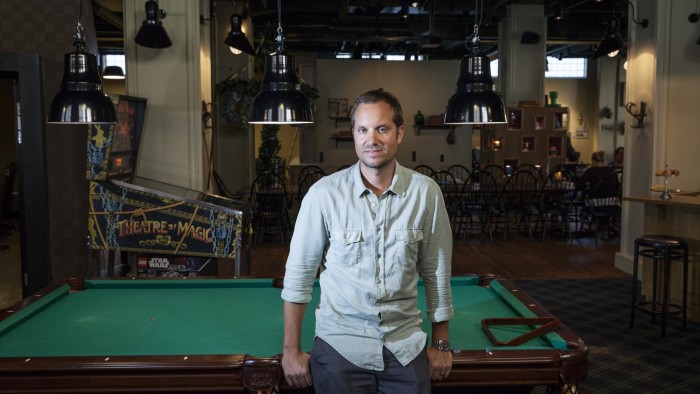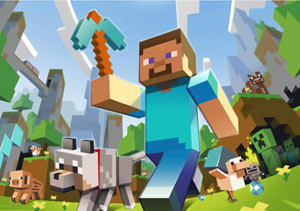Mojang: smash-hit ‘Minecraft’ maker

Simply sign up to the European companies myFT Digest -- delivered directly to your inbox.
To celebrate selling 10m copies of its computer game Minecraft, Swedish start-up Mojang decided to treat all its workers to a surprise trip last year.
After breakfast at its Stockholm headquarters, employees were whisked off in limousines, private jets and a fleet of Ferrari and Lamborghini super cars to Monte Carlo. Two days of partying ensued involving casinos, helicopter trips to restaurants and dancing on a yacht with Norwegian group Röyskopp as a DJ set.
This year, it plumped for just a boozy ferry trip across the Baltic. Not that Mojang has had a bad year: Minecraft, a sort of digital version of Lego in which players use blocks to build a virtual world, helped bring in SKr2.1bn in revenues (up 38 per cent on the previous year) and SKr816m of profit in 2013.
Carl Manneh, Mojang’s chief executive, says: “This year we wanted to do something completely different and this is something most Swedes – at least from Stockholm – do when they are young and stupid.”
Since it was created five years ago, Minecraft has become a technology phenomenon and one of the biggest-selling games in history. By the end of June it had sold about 54m copies, a figure that is rising all the time – in 24 hours at the start of this week, 18,537 people handed over €20 or the equivalent for a PC copy.
Minecraft’s success is all the more remarkable for what it lacks: the graphics are blocky and unsophisticated, it has few characters and not much of a plot. Instead, players set about building just about any kind of virtual world they can imagine: creations include entire cities, sets from films, space shuttles and even a replica model of Denmark.

Mojang’s approach to business has also been different. It has taken no outside investment, rebuffing numerous venture capitalists and other would-be backers that include Napster founder Sean Parker. Minecraft has become wildly successful on smartphones and tablets despite eschewing the dominant free-to-play – “freemium” – model of games such as Candy Crush Saga and Clash of Clans.
It also has Mr Manneh as chief executive rather than its co-founders, Markus Persson – creator of Minecraft, better known as “Notch” – and Jakob Porser. Messrs Persson and Porser wanted to concentrate on making games and so approached Mr Manneh, Mr Persson’s former boss at another Swedish start-up, to run and develop the business itself.
“A lot of indie game developers are trying to do everything themselves – they’re game developers, marketers, CEO and all of the ‘hats’ that basically take time away from what they’re really talented at,” Mr Manneh says. In open-necked shirt with sleeves rolled up, he is sitting in a leather chair in a room that not only has a pool table, pinball table and jukebox but a wall covered in gilt-framed, old-fashioned portraits of the first 20 or so Mojang employees in different guises. Mr Manneh is portrayed as a golf player.
The three men are the sole owners of Mojang and Mr Persson remains chairman but keeps his distance from his CEO. “In operational areas, he’s very good at letting go and letting people handle it, [people] who are more interested and experienced in those areas,” Mr Manneh says.
Not that Mr Persson does not create mischief for his CEO. An active blogger and presence on Twitter, he created a stir in 2011 when he announced he had sold Mojang to Mr Parker, only to say later it was an April Fool’s joke. Earlier this year, Mr Persson tweeted that there would be a Minecraft movie from Warner Bros – the studio that developed The Lego Movie – leading to a deluge of calls to an unsuspecting Mr Manneh. (Nearly all Mojang’s 37 employees are on Twitter and they post much of what they are up to every day.)
The two men’s relationship dates back to 2009 when Mr Manneh was CEO of JAlbum, a photo-sharing website where Mr Persson worked. In his spare time Mr Persson developed Minecraft and within a few months it was making nearly as much money as JAlbum, which had more than 1m users.
Eventually Mr Persson quit JAlbum to found an independent games studio with Mr Porser, a fellow game developer. The plan was to develop other games but instead Minecraft became a bigger success than anybody imagined. “It was fun to build the blocks but I couldn’t really see the potential,” admits Mr Manneh, his voice trailing off. However, it was soon clear that Minecraft alone was making more than JAlbum.
Now, Mr Manneh says, his role is to act as a “big filter”, adding: “The most common word I say is ‘no’.”
Some games companies that enjoy big success have looked to cash in as much as possible – such as Finland’s Rovio, which has licensed Angry Birds to brands from soft drinks to fishing rods. Mojang has taken a lower-key approach. Perhaps its most high-profile partnership is the most obvious one: Lego. Minecraft is widely seen as the game the Danish toymaker should have made in its attempt to conquer the digital world but its own plan, Lego Universe, flopped.
Instead, the privately owned toymaker is now collaborating with the Swedish start-up on a second batch of Minecraft sets, due in a few months. In a striking reversal, Mojang executives even think the small newcomer can take children back to the original spirit of Lego.
Vu Bui, Mojang’s chief operating officer, says most Lego sets these days offer “a perfect picture of something that you want to build, and then it’s done”. By contrast, the Minecraft sets will encourage people to tear them apart and rebuild. “I know that at Lego part of its culture is to want people to remember they can rebuild things,” he adds.
Mojang remains dependent on one product but Minecraft’s continuing success has dulled questions about developing other games. Mr Porser developed Scrolls, a cross between a board game and collectible cards, but it has failed to come near the success of Minecraft.
The pressure has been tougher on Mr Persson to follow up Minecraft. He announced plans in 2012 to launch a game called 0x10c but soon shelved it. Instead his first post-Minecraft game was the release in June of the throwaway Cliffhorse, knocked out in a few hours, according to Mr Persson’s tweets.
Mr Manneh is unfazed by the lack of a follow-up, explaining that Minecraft continues both to grow and to be improved. “In a way we’re following Minecraft up by iterating Minecraft and that’s the nice thing about it – it’s ever-evolving,” he says.
Further reading: community action
Minecraft creator Mojang’s size marks it out from other successful gaming companies, writes Richard Milne. With just 37 employees, the Swedish start-up lags behind well behind the 140 at Finland’s Supercell, 800 at King Digital Entertainment, 800 at Rovio or the 3,000 that Zynga employed at its peak.
Carl Manneh, Mojang CEO, says: “We think there is a strength in having small teams – you can move faster, take decisions faster. It also forces you to create games that are not as heavy on development so you don’t have to make games that require 200-300 people.”
Mojang has also deliberately recruited employees from what Mr Manneh calls its community: the players and fans who modify the game. Two makers of an unofficial way to modify Minecraft called Bukkit were hired by Mojang to try to make it legitimate. Mojang’s “director of fun” Lydia Winters was a popular maker of Minecraft YouTube videos.
Mr Manneh says the community is more powerful than the lure of money dangled by commercial proposals. “Our most valuable asset is our relationship with our community. So everything we do in terms of commercial partnerships comes back to community and not how big the pile of money is. If it doesn’t make sense for the community or the brand, then it’s an easy decision to say no.”
Comments